PRODUCED WATER REPORT
Vertical-tube evaporator system provides SAGD-quality feed water
Mechanical vapor compression evaporators are rapidly becoming the produced water treatment option of choice for supplying Alberta heavy oil producers with steam for SAGD. Here’s why.
William F. Heins, GE Water & Process Technologies; and Rob McNeill,* Total Canada
Water treatment and steam generation methods for heavy oil recovery processes have evolved rapidly. Traditionally, Once-Through Steam Generators (OTSGs), driven by natural gas, have been used to produce about 80% quality steam (80% vapor, 20% liquid) for injection into the well to fluidize the heavy oil, especially for cyclic steam operations. However, the more recent Steam-Assisted Gravity Drainage (SAGD) method requires 100% quality steam for injection. The use of OTSG for SAGD applications requires a series of vapor-liquid separators to produce the requisite steam quality. For both SAGD and non-SAGD applications, pre-treatment of the OTSG feed water has consisted of silica reduction in a hot or warm lime softener, filtration and hardness removal by Weak Acid Cation (WAC) ion exchange. In most cases, the OTSG blowdown is disposed by deep well injection.
As the use of SAGD increased, the traditional produced water treatment and steam generation methods were re-evaluated to determine whether alternative methods may provide more technically and economically viable solutions. One such alternative, the use of vertical-tube Mechanical Vapor Compression (MVC) evaporation, has rapidly become the “baseline” approach against which other technologies are evaluated. Several Alberta oil producers have found this technology to provide numerous advantages over the traditional approach. In addition, the method allows the use of standard or “packaged” drum boilers in lieu of OTSG for steam generation, providing further technical and economic benefits.
PRODUCED WATER TREATMENT METHODS
A technical and economic comparison of MVC evaporative produced water treatment and steam generation with the traditional approach requires a brief summary of each technology.
Traditional treatment. The traditional produced water treatment system has been applied to both SAGD and non-SAGD applications. The process that reduces silica to low enough levels to be used in an OTSG is a warm or hot lime softener (WLS or HLS) followed by a filtration system. Calcium and magnesium are also reduced in the lime softener, which lightens the load for the WAC ion exchange system. The major chemicals added in the softener are lime and magnesium oxide. These chemical systems require chemical silos and solids transport equipment. Other chemical additions are also required in the form of a coagulant and a polymer. The chemical additions reduce silica content to manageable levels for the OTSG.
The clarate is filtered before the WAC ion exchange treatment, which reduces magnesium and calcium. Sludge produced from this softening process has high water content; it is separated by a centrifuge and then requires disposal. Centrate is recycled back to the process.
The WAC ion exchange system is regenerated with hydrochloric acid and caustic. Metals such as calcium, magnesium and iron are reduced in the exchange process. WAC does not reduce silica beyond the lime softener’s reduction. The strong regeneration waste is neutralized and possibly recycled to the softening system or disposed in some other manner. The resin-bed rinses are recycled to the softening system.
Conventional treatment of produced water for an OTSG produces a blowdown that is about 20% of the boiler feed water volume and results in brine stream about five times the concentration of the boiler feed. This stream requires disposal by deep well injection or by further concentrating the blowdown with a Zero-Liquid-Discharge (ZLD) brine concentrator and crystallizer, producing a dry solid for disposal. Some of the OTSG blowdown can be recycled to the softener system, but as the solids are cycled up in the system, the OTSG’s maintenance needs increase.
Vertical-tube, falling-film MVC method. The heat transfer coefficient for vertical-tube, falling-film evaporators is higher than for traditional evaporators, offering improved evaporation efficiency and energy savings. This arrangement, in conjunction with a proprietary brine distribution system, allows evaporation to occur with reduced fouling by keeping surfaces perpetually wetted, Fig. 1.
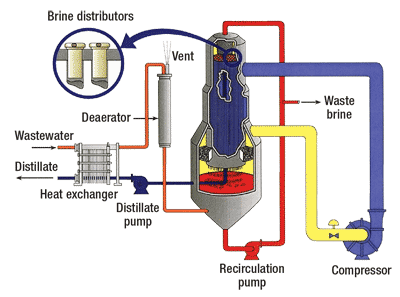 |
Fig. 1. A schematic of a vertical-tube, falling-film Mechanical Vapor Compression (MVC) evaporator.
|
|
The vapor compression cycle is the key to energy efficiency in these systems. Only about 5% of the energy needed to evaporate water is new input energy, because the compression energy is used to elevate the steam temperature without having to provide the initial energy to evaporate the water. The steam temperature and pressure is elevated, and the steam is then condensed, transferring heat to the brine for evaporation, which produces steam for the compression cycle. This arrangement makes the vertical-tube, falling-film MVC system much simpler than the traditional physical-chemical produced water treatment system, Fig. 2.

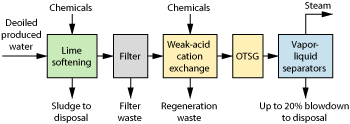
|
Fig. 2. The vertical-tube, falling-film Mechanical Vapor Compression (MVC) evaporation system for produced water treatment and steam production (top) has a much simpler configuration than the traditional physical-chemical produced water treatment system (bottom).
|
|
De-oiled produced water enters a feed tank where the pH is adjusted. The wastewater is pumped to a heat exchanger that raises its temperature to the boiling point. It then goes to a
deaerator, which removes non-condensable gases such as oxygen. Hot, deaerated feed enters the evaporator sump, where it combines with the recirculating brine slurry. The slurry is pumped to the top of a bundle of 2-in. heat transfer tubes. Proprietary liquid distributors ensure a smooth, even flow of brine down each tube. As the brine flows down the tubes, a small portion evaporates, and the rest falls into the sump to be recirculated.
The vapor travels down the tubes with the brine and is drawn up through specially designed mist eliminators on its way to the vapor compressor. Compressed vapor flows to the outside of the heat transfer tubes, where its latent heat is given up to the cooler brine slurry falling inside. As the vapor loses heat, it condenses as distilled water. The distillate is pumped back through the heat exchanger, where it gives up sensible heat to the incoming wastewater. A small amount of the brine slurry is continuously released from the evaporator to control density.
The OTSG or drum boiler blowdown can be recycled to the evaporator feed, eliminating the need to dispose of this waste stream without affecting recovered water quality. The evaporator blowdown is disposed via deep well injection or treated further by a crystallizer to eliminate all liquid waste. The crystallizer produces a dry cake material for disposal.
The brine disposal method must be known before designing the evaporator system. Crystallization can process highly dispersed brines, while physical-chemical treatment may be more problematic. Adjustments are required for neutralization and filtering when dispersants are present in concentrated brine. Evaporative systems designed to produce brines for disposal sometimes require modified scale prevention techniques.
EMERGENCE OF VERTICAL-TUBE MVC
The emergence of evaporators followed by conventional drum boilers as the preferred produced water treatment and steam generation process for SAGD evolved over several years of demonstrated performance starting in 1999. Evaporation was initially used in two SAGD applications by Japan Canada Oilsands and PetroCanada, respectively, in conjunction with WLS/WAC systems. The blowdown from the OTSG steam separators was effectively processed by an evaporator and crystallizer combination in a ZLD system. All water was recycled in this plant, with only solids discharged offsite. The plant’s success demonstrated that evaporation of produced water could be done with high reliability.
In 2002, evaporation was selected to replace the traditional WLS/WAC process to treat produced water at the Suncor Firebag Stage 2 facility. At this location, produced water is concentrated about 60 times, with the evaporator distillate used as makeup to an OTSG. Drum boilers were not selected at that time since there was insufficient data to ascertain that the evaporation process could reliably produce distillate with sufficient quality to be used with high-pressure drum boilers. Two more similar facilities were installed in 2002 and 2003, which provided additional data regarding the reliability and technical viability of the evaporation process.
In 2004, Deer Creek Energy (now Total Canada) installed a produced water evaporation system followed be a standard, packaged drum boiler in lieu of an OTSG at the company’s Joslyn Phase II facility. Total also decided to install a ZLD crystallizer to reduce the evaporator waste to a dry solid.
Today, there are about 16 produced water evaporators operating or under construction in nine plants in Alberta and overseas. Of these nine plants, eight are new facilities, while one was an existing plant that switched to evaporators from a WLS/WAC system. Of dozens of new SAGD facilities that are in the planning stages and are due to be released for construction, some as early as this year, to our knowledge only one is not designed for the evaporative produced water treatment approach. The increasing use of produced water evaporators in lieu of WLS/WAC may significantly advance SAGD technology and increase its economic viability.
TECHNICAL AND ECONOMIC COMPARISON
Since the first implementation of SAGD evaporative produced water treatment in 2002, many if not most Alberta oil producers have conducted studies to determine whether evaporative treatment or traditional methods provide the most technically and economically viable solution for their specific application. These studies have been conducted for facilities producing as little as 10,000 bpd of bitumen, and for facilities producing more than 200,000 bpd.
It was first thought by many in the industry that evaporative treatment may only be economically viable for small facilities (i.e., less than 30,000 bpd bitumen). Initial studies, conducted around 2003, seemed to validate this assumption. However, as more capital, installation and operating cost data became available from the evaporative produced water treatment systems installed in Alberta, the results showed that the evaporative method was technically and economically viable for large facilities as well. In fact, studies conducted at four Alberta plants in 2006-2007 by independent industry consultants and oil companies show that the economics are at least as advantageous, if not more so, for larger facilities as compared with smaller applications.
Of 10 studies of planned or existing SAGD facilities in the past few years by oil companies and independent contractors, 9 favored the use of SAGD. At least one study of an existing plant concluded that keeping its WLS/WAC system was more economical. The information below compiles data and conclusions drawn from these 10 studies. While specific economic parameters and assumptions vary by site, the conclusions drawn are consistent among the studies conducted. Following the general conclusions presented below, specifics on economic comparisons are also presented.
Technical comparison. The studies concluded that the traditional de-oiling, softening, filtration, and ion exchange produced water treatment scheme (Fig. 2, bottom) is complex, costly, produces several waste streams, is labor intensive, requires the use of OTSG and requires vapor/liquid separation systems to produce the 100% steam quality required for SAGD. Evaporation was found to be simpler, more cost-effective and more reliable. The lime softener (WLS or HLS), filtration, WAC exchange systems and possibly certain deoiling steps are eliminated.
Using evaporation as the treatment process instead of lime softening and WAC has several technical advantages. Among these:
- Evaporators effectively “decouple” the produced water system from the boiler feed system, such that upsets in de-oiling do not reach the steam generators
- Evaporation is evaluated as a more robust and reliable technology, and can be used on produced and makeup waters that are harder to treat
- Boiler feed quality is dramatically improved (by almost four orders of magnitude), resulting in improved boiler reliability
- Evaporation is the only proven method of treating produced water to meet feed water requirements for the use of drum boilers
- Evaporative treatment coupled with drum boilers allows for the use of alternate fuels
- Vapor-liquid separators are eliminated, since drum boilers produce 100% quality steam
- Physical separation processes using solid chemical additions are eliminated, reducing unit operations and chemical handling
- High-water-content sludges are eliminated
- Overall operational and maintenance requirements are reduced
- Evaporation maximizes water recovery and reuse, reduces makeup water requirements by 50-70% and minimizes or eliminates liquid blowdown
- Evaporation allows for the use of brackish water for makeup rather than surface water; this is particularly important given the large number of SAGD projects expected to proceed in Alberta
- If ZLD is required, evaporation results in a much smaller ZLD system than that required if the physical-chemical treatment approach is used
- Boiler blowdown is recycled to the evaporator feed, eliminating disposal requirements
- Size and complexity of boiler blowdown and heat recovery equipment is reduced
- Turndown capabilities are improved for both the water treatment system and the boiler system; this is particularly useful during startup and ramp-up periods
- More rapid startup is allowed
- Oil removal equipment may be reduced.
Technical advantages of the traditional approach, using WLS, WAC and OTSG, over the evaporative method include:
- Although fouling severity and frequency have been minimal in operating produced water evaporators, there is a risk that severe fouling could limit steam production. The traditional approach eliminates this risk
- Drum boilers cannot be “pigged” like OTSG; chemical cleaning is required
- OTSG does not require as high-quality water as drum boilers.
When comparing evaporative produced water treatment, including the use of drum boilers for steam generation, to the traditional method, oil producers and engineering firms have concluded that the technical advantages of the evaporative approach far outweigh the advantages of the traditional method.
Economic comparison. Several economic studies over the past three years have compared the evaporative and traditional approaches. The results of the economic evaluations are dependent upon the assumptions used to conduct the comparison. For example, if a fully modularized design is assumed, the installation costs for the facility will be dramatically lower than otherwise. Modularization may benefit one produced water treatment approach over the other, depending on the relative installation costs for the two approaches, and is always recommended for evaporative treatment systems.
Many of the 10 studies summarized here have been conducted in the past 12 months. Some studies included the use of ZLD, and others assumed post-treatment of the evaporator blowdown followed by deep well injection. All but one of the studies concluded that evaporation is more economical, on both an installed capital and a life-cycle cost basis, than the traditional approach.
Facility sizes range from 10,000 bpd of bitumen production to more than 200,000 bpd with steam-to-oil ratios ranging about from 2.5 to 3.5.
The evaporative method combined with drum boilers resulted in 8-10% lower total installed costs for the combined oil treating, water treating, steam generation and heat recovery facility, assuming a modular evaporator system. Capital costs for the entire facility, before installation, were typically about equal for the evaporative and traditional approaches. The majority of the savings was in installation. For cases where a ZLD system was included, selecting evaporation resulted in total installed-cost savings of about 4-7%.
The evaporative approach resulted in 1-6% lower operating costs over the life of the plant. This value does not only take into account the operating cost comparison between the two water treatment methods, but also the operating costs associated with steam generation (i.e., a comparison of drum boiler and OTSG operating costs, including boiler blowdown heat recovery and handling systems and fuel consumption). To summarize the major economic parameters compiled from these studies:
- Fuel consumption for the drum boiler was 1-5% lower than for the OTSG, depending on such factors as boiler feed temperature. Fuel consumption can account for 80-95% of the system’s total operating cost, depending on the fuel source. Therefore, even a 1% fuel savings provides a significant advantage for the evaporative approach.
- Use of drum boilers allows alternate fuels, which can result in significant energy savings compared with natural gas. Although the studies assumed that alternate fuels can only be used with the evaporative/drum boiler approach, the comparisons do not reflect the use of alternate fuels. That is, credit has not been given in the economic evaluation for the use of alternate fuels.
- Electrical costs for the evaporative approach were typically 30-40% higher than the traditional approach. Electricity accounted for about 4-15% of the total system operating cost. This relatively wide range is due to differing sources and costs of boiler fuel. If natural gas is used (high cost), the fraction of the operating costs due to electricity is lower, whereas if an alternate fuel is used, the electrical cost becomes more significant.
- Total chemical costs for the evaporative approach were about 10-20% lower than for the traditional approach. This is despite the fact that the evaporation system uses considerably more caustic than the traditional approach. Chemicals accounted for about 3-5% of total operating costs.
- Source water and disposal costs were about 40-60% lower for the evaporative approach. These items contribute about 1% of the overall operating cost.
- Other miscellaneous costs, which amount to about 1% of the total operating costs, were roughly equivalent for the two treatment methods.
The evaporative approach resulted in significant Net Present Value (NPV) savings. The majority of these is attributed to total installed cost savings of the facility and reduced consumption of boiler fuel (either natural gas or alternate fuels). If alternate fuels are used, the savings are dramatic since fuel consumption amounts to about 80-95% of the total operating costs. NPV savings were about $10-25 million per 10,000 bpd of bitumen production, excluding the use of alternate fuels.
Significant reductions in operating and maintenance costs (materials and labor), in the range of 10-20%, were realized with the evaporative approach.
Reduced sludge disposal and waste handling costs of about 30-60% were realized for the evaporative approach. The evaluations included costs for post-treatment of the evaporator blowdown before deep well injection or, in some cases, included costs associated with ZLD.
A 4-8 month reduction in overall project schedule was realized with the evaporative approach. This includes schedule savings associated with the use of drum boilers in lieu of OTSG.
Due to the simplicity and reliability of evaporative produced water treatment, a 2-3% increase in the entire facility’s onstream availability is anticipated with its use. This advantage, not applied to the economic analysis results above, would further improve the NPV savings and increase oil production for the evaporative approach. If a co-generation facility were available, the operating cost savings and NPV savings would be further increased for the evaporative approach.
The evaporator and drum boiler combination provides improved turndown capability, which significantly improves both economics and operability during the ramp-up phase of the SAGD facility.
These economic advantages, coupled with the previously discussed technical advantages, have resulted in a shift to the evaporative approach in the past few years.
EVAPORATOR OPERATIONAL DATA
In 2005, two Alberta-based and two overseas produced water evaporator system startups were conducted. Since that time, each system has operated with over 99% onstream availability, has experienced no fouling or evaporator heat transfer degradation, has operated up to 116% of design capacity, has produced distillate of sufficient quality to be used as makeup to standard drum boilers, has consumed less than the design amount of electrical power and has required minimal operator attention.
Evaporator and steam generator sampling plan and results. In February 2006, GE implemented an analytical sampling plan to evaluate the water quality associated with certain produced water evaporator and steam generation subsystems within one Alberta SAGD plant. Samples of the deoiled produced water, evaporator feed, distillate and blowdown, and OTSG feed and blowdown were analyzed. Specific analyses included all major cations and anions, metals, silica (reactive and non-reactive), total dissolved solids, total suspended solids, Total Extractable Hydrocarbons (TEH-60), Total Organic Carbon (TOC), Volatile Organic Acids (VOA), oil and grease (O&G), total solids at 105°C and 180°C, and other miscellaneous analyses. To summarize the significant results:
- The distillate produced by the evaporator system was of sufficient quality to be used in high-pressure drum boilers
- Evaporator feed was typical of Alberta produced water containing 225 mg/L TOC, 45 mg/L O&G and 154 mg/L silica
- Total solids-the sum of inorganic constituents and non-volatile organic constituents-were non-detectable (less than 0.7 mg/L) in the distillate at 180°C. Total solids at 105°C were 2.2 mg/L, indicating that about 1.5 mg/L of organics was present that volatilized readily above 105°C
- Total non-volatile extractable hydrocarbons in the distillate were estimated at 0.02 mg/L. Volatile extractable hydrocarbons were 0.70 mg/L.
- The OTSG blowdown contained only 0.08 mg/L of detectable extractable species, all in the C11-C12 carbon chain range (the most volatile species in the TEH-60 analysis). All species in the C13-C60 range were non-detectable
- Distillate O&G concentrations were non-detectable and estimated at less than 0.04 mg/L. The ASME limit is 0.2 mg/L for boilers over 1,000 psig
- OTSG blowdown O&G was non-detectable at less than 0.2 mg/L
- No detectable VOAs were present in the distillate
- Silica in the OTSG blowdown was 0.2 mg/L
- No detectable hardness was present in the distillate or OTSG blowdown
- Lithium, iron and copper were all non-detectable in the evaporator distillate and well below the ASME limits.
Heat transfer data and fouling characteristics. Figure 3 plots evaporator heat transfer performance as a function of time at the plant. The evaporator heat transfer coefficients measured in September 2005 and February 2006 are virtually identical, indicating that no degradation of heat transfer performance occurred.
The heat transfer coefficients throughout the duration of the data collection are consistently in the range of 130% of the design “clean” heat transfer coefficient. This is attributed to better than expected fluid heat transfer characteristics (i.e., physical properties of the fluid) and a degree of conservatism in the projected design heat transfer coefficient used for equipment sizing.
About four months into the data collection, the heat transfer coefficient temporarily dropped to about 80% of the clean value. This drop is attributable to a long-term upset in the deoiling process upstream of the evaporation system, which increased the oil content of the evaporator sump and, consequently, altered the physical characteristics of the fluid in the evaporator (i.e., higher viscosity, higher specific gravity and increased resistance to heat transfer). However, after the upset was rectified and the fluid characteristics returned to design conditions, the heat transfer coefficient immediately rebounded to the previous value of about 130%. This indicates that the de-oiling upset did not result in fouling of the evaporator heat transfer surfaces.
In the original evaporator design, it was anticipated that the evaporators would need to be cleaned about once every 4 months. Cleaning would be required, based on vapor compressor limits, when the heat transfer coefficient was consistently at about 62% of the clean value, as indicated by the lower dashed line in Fig. 3. However, after 8 months of operation, the heat transfer coefficient is the same as it was immediately after startup. The evaporators did not need to be cleaned for several more months after the initial 8-month operational period.
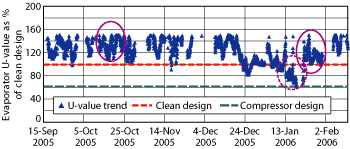 |
Fig. 3. Produced water evaporator heat-transfer performance. The vertical axis is expressed as a percentage of the design “clean” heat transfer coefficient. That is, 100% on the vertical axis is the heat transfer performance that would be expected upon startup under perfectly clean conditions.
|
|
Evaluating the position of the compressor guide vanes as a function of system capacity offers another indication that the evaporator heat transfer surfaces have not experienced any fouling, Fig. 4. If the evaporator is free of scaling or fouling, the compressor guide vane position tends to increase linearly with evaporator capacity. If the evaporator is fouling, the compressor guide vane setting will increase over time for a given system flowrate, because the compressor must operate at a higher discharge pressure to produce a given amount of distillate. Since the compressor guide vane setting in Fig. 4 shows a strong linear relationship with system capacity, it is apparent that the evaporator has not experienced fouling.
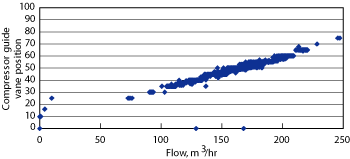 |
Fig. 4. The linear plot of compressor guide vane position vs. system capacity indicates that the evaporator is operating free of scaling or fouling.
|
|
Energy consumption and fouling characteristics. One of the most important and reliable methods of identifying evaporator fouling characteristics is to evaluate the system electrical consumption over time. This indicator is of particular interest since electrical consumption is the single largest operating cost of the evaporator system. Therefore, minimizing fouling results in reduced operating costs.
Figure 5 provides data from the plant for evaporator system electrical consumption as a function of time for two one-week periods three months apart, operating at approximately 75% of full design capacity. If the evaporators were slowly fouling, the electrical consumption at the later one-week period would be expected to be greater than at the earlier one-week period for a given flowrate. However, the data indicates that the electrical consumption per 1,000 gallons of water processed is essentially flat, strongly indicating that fouling is not occurring. Energy consumption, at 75% capacity, is about 73 kWh/1,000 gallons of distillate produced (which equates to about 70 kWh/1,000 gallons at 100% capacity, where the compressor efficiency is at its design value). This is about 5% lower than the expected electrical consumption under commercially clean conditions.
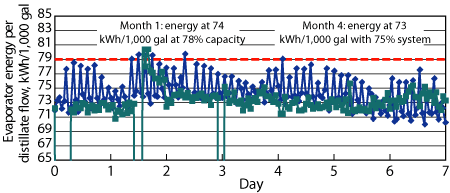 |
Fig. 5. The electrical consumption per flowrate for the evaporator system is essentially the same for two one-week periods separated by three months, strongly indicating that fouling is not occurring.
|
|
Energy consumption and system capacity. The amount of electrical energy that an evaporation system consumes depends on several factors including evaporator heat transfer area, cycles of concentration in the evaporator, state of evaporator fouling and the capacity at which the evaporator is operating.
Figure 6 plots electrical consumption per 1,000 gallons of distillate produced vs. capacity at the design cycles of concentration at the plant. This plot does not need to be corrected to account for fouling, as there is no evidence of any. Per-production electrical consumption decreases as production increases toward 100% capacity and then increases above 100% capacity. The higher electrical consumption at turndown and at conditions above 100% design flow is attributed to the vapor compressor operating at a less efficient point than at 100% flow. Typically, the compressors are designed to operate most efficiently at 100% flow where, presumably, most of the operation will take place.
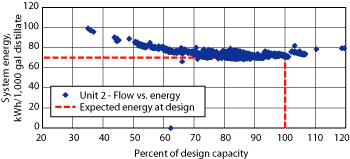 |
Fig. 6. Produced water evaporator electrical consumption vs. system capacity. Design flow at 100% capacity in clean conditions is expected to be 70 kWh/1,000 gal if zero-liquid-discharge is not included in the design.
|
|
It is important to note that a typical produced water evaporator will consume 60-65 kWh/1,000 gallons of distillate (as compared with the 70 kWh/1,000 gallons seen in this evaporator). The reason for the higher consumption is that the system was designed to have a crystallization device downstream and, therefore, the cycles of concentration are higher than would otherwise be required. The higher cycles of concentration increase the vapor compressor electrical consumption to overcome the associated increase in boiling point of the brine within the evaporator. Electrical consumption of less than 60 kWh/1,000 gal can be achieved by modifying the evaporator configuration.
CONCLUSIONS
The combination of vertical-tube, falling-film evaporation and standard drum boilers has several technical advantages over the traditional approach, including increased reliability, reduced maintenance and operations requirements, less chemical handling and increased simplicity. Economic advantages include reduced capital, operating and lifecycle costs, and the potential for an accelerated project schedule. The potential use of alternate fuels in the drum boiler further enhances the economic advantages of evaporative produced water treatment.
Environmental benefits to the evaporative approach include use of brackish water in lieu of surface water and minimizing or eliminating liquid discharge.
Based on the technical and economic advantages of the evaporative produced water treatment approach, there has been a “paradigm shift” in SAGD produced water treatment technology away from traditional methods and instead focusing on evaporative treatment. Economic comparisons of produced water treatment approaches are site specific and detailed conclusions will vary. However, there is a consensus in the industry that the majority of new SAGD facilities will use evaporative treatment methods, with a minority continuing to utilize traditional methods. 
|
THE AUTHORS
|
|
William F. Heins is an evaporator and Zero Liquid Discharge (ZLD) specialist and the business leader for GE Water & Process Technologies’ Thermal Products business (formerly RCCI) located in Bellevue, Washington. Mr. Heins is a chemical engineering graduate from the University of Wisconsin and has been with RCCI for 17 years. Since joining the company, Mr. Heins has led the development and implementation of GE’s patented produced water evaporators, ZLD systems, brine concentrators and crystallizers. He was responsible for the implementation of the world’s first four SAGD ZLD systems and the first 12 produced water evaporators, which were recently provided by GE to facilities in northern Alberta and overseas. Before joining GE, he was a nuclear engineer in the US Naval Submarine Program.
|
|
| |
Rob McNeill is the project manager for the Great Divide SAGD project owned by Connacher Oil & Gas. He joined the firm in a consulting role in January 2006. Previously, Mr. McNeill filled a similar role for Total E&P Canada (formerly Deer Creek Energy) for the execution and startup of its Joslyn Phase II SAGD facility. Mr. McNeill holds a BS degree in chemical engineering from the University of Calgary, and has over 20 years of domestic and international project and operations experience in the energy industry.
|
|
|










